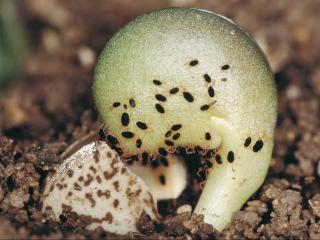Western Australia
February 25, 2021

DPIRD research that found intensive spring grazing could control red legged earth mite as well as insecticides will be profiled at the Albany GRDC Grains Research Updates 2021 next week as part of a Pesky Pests presentation
New intelligence on how to improve integrated pest control strategies for some of the State’s most significant grains and pasture pests will be revealed next week.
The Grains Research and Development Corporation’s (GRDC) Research Updates 2021 in Albany on Monday, 3 March will be given a debrief on the findings from several pest research projects by the Department of Primary Industries and Regional Development.
Department research scientist Svetlana Micic will share with the audience how intensively grazing pastures in spring could effectively control red legged earth mite (RLEM) as effectively as insecticides.
“On-farm trials at Boyup Brook, Cranbrook and Kalgan found grazing the food on offer (FOO) down to at least two tonnes of dry matter per hectare for four weeks around the Timerite™date reduced pest numbers to below damaging levels,” Ms Micic said.
“This strategy is recommended when the RLEM population in pastures is above 5000 per square metre and the FOO is more than three tonnes of dry matter per hectare.”
Another project will be profiled that surveyed the pests and natural enemies associated with harvest weed seed control systems, which had co-investment from the GRDC.
The survey across five port zones showed more pests, such as European earwigs and slaters, were found under the chaff before sowing than after crop germination.
“The results suggest that after sowing these pests move out from chaff into the paddock,” Ms Micic said.
“It also highlighted that paddocks located in the Esperance and Albany Port Zone had a higher abundance and diversity of invertebrates.
“In these Port Zones paddocks with chaff dumps also had higher pest and natural enemy numbers than paddocks with lines.
“This information will assist growers to know what is likely to be in the paddock before sowing to prevent crop damage during the growing season.”
Other department research scientists speaking at the event include Jeremy Curry on getting the best out of barley, Jackie Bucat on canola varieties and agronomy considerations and Sarah Collins and Carla Wilkinson on the outcomes of a root disease survey.
After lunch colleagues Brenda Shackley will discuss wheat varieties and agronomy tips, Stacey Power will provide the latest information on faba bean agronomy and Geoff Thomas and Kith Jayesena will give an overview of crop diseases in the south.
Before the plenary session research scientist Glenn McDonald and a panel of growers will discuss their experiences with soil amelioration for non-wetting soils.
The Albany GRDC Grains Research Update will be held on Wednesday, 3 March from 9am to 5pm at the Albany Entertainment Centre. Visit the GRDC Upcoming Updates and Events webpage for more information..